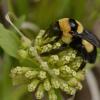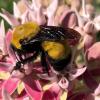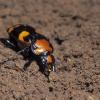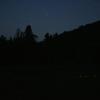
(Odonata: Anisoptera: Corduliidae)
Somatochlora franklini inhabits sedge- and moss-filled fens in northern North America. Although this species is widely distributed across Canada, it is unranked or considered imperiled in most US states. Like other members of its genus, habitat disturbance and alteration are the greatest immediate threats to this species. Specific activities that alter fen habitat include peat mining, wetland grazing, manipulation of water levels, and recreation. Continued protection and management of bog/fen habitat is essential to the preservation of this, and other, ecologically unique species.
Adult: Characteristic of the Corduliidae, the eyes are contiguous and the anal loop of the hindwing is distinctive (somewhat foot-shaped, but with little development of the toe). Somatochlora is distinguished from the other genera in this family by the metallic, dark-green abdomen and the pointed (as opposed to forked) inferior anal appendage at the tip of the male abdomen. Somatochlora franklini is a very slender emerald with a dark brown triangle at each hindwing base. The face is black with yellow on the sides. The male thorax is metallic green mixed with some brown; the female thorax is brown mixed with green. The thorax of both sexes lacks spots or lines. The male abdomen is black with dull brown spots on the sides of segments 1 and 2, and a dull yellow ring at end of segment 2; the female abdomen has dull orange dorsolateral spots on segment 3. Female eyes stay reddish for much of life, then become green. The body length of this species is 44-54 mm (1.7-2.1 in.) (Paulson 2008, pers. comm.).
The very slender abdomen, coupled with the brown mark on the base of the hindwing, helps distinguish this species. The two other species with a brown wing mark (S. whitehousei, S. septentrionalis) have much shorter abdomens and very different male and female appendages. Other similar species (S. semicirucularis, S. kennedyi, S. forcipitata, S. brevicincta) lack the brown wing mark and have less slender abdomens, although it should be noted that the wing spot is not extremely obvious in the field (Paulson 2008, pers. comm.). Examination of male and female appendages may be necessary for conclusive identification. Male cerci appear forcep-like from above, and resemble a simple slightly droopy and pointed finger from the side. The female subgenital plate is the length of segment 9, and does not project (Paulson 2008, pers. comm.).
Immature: Larvae in this family are generally stout and hairy. Somatochlora in the Pacific Northwest can be identified to genus as follows: prementum and palpal lobes cup-shaped (as opposed to flat), palpal lobe with small, regular teeth (as opposed to large, irregular teeth), head without erect, frontal horn, ventral surface of prementum with a basal, median groove, dorsal hook absent on abdominal segment 2, and sides of thorax uniformly colored without dark longitudinal stripe (Tennessen 2007). Species identification is difficult for a non-expert, but see Bright (2005).
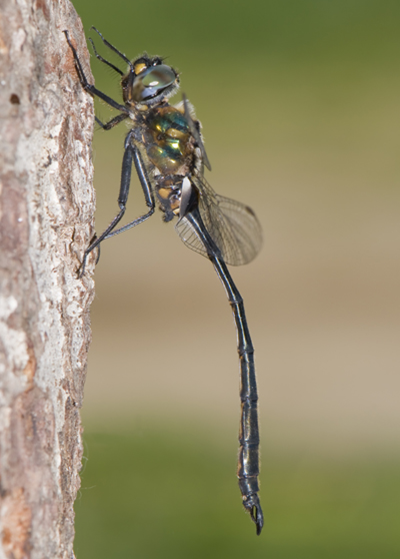
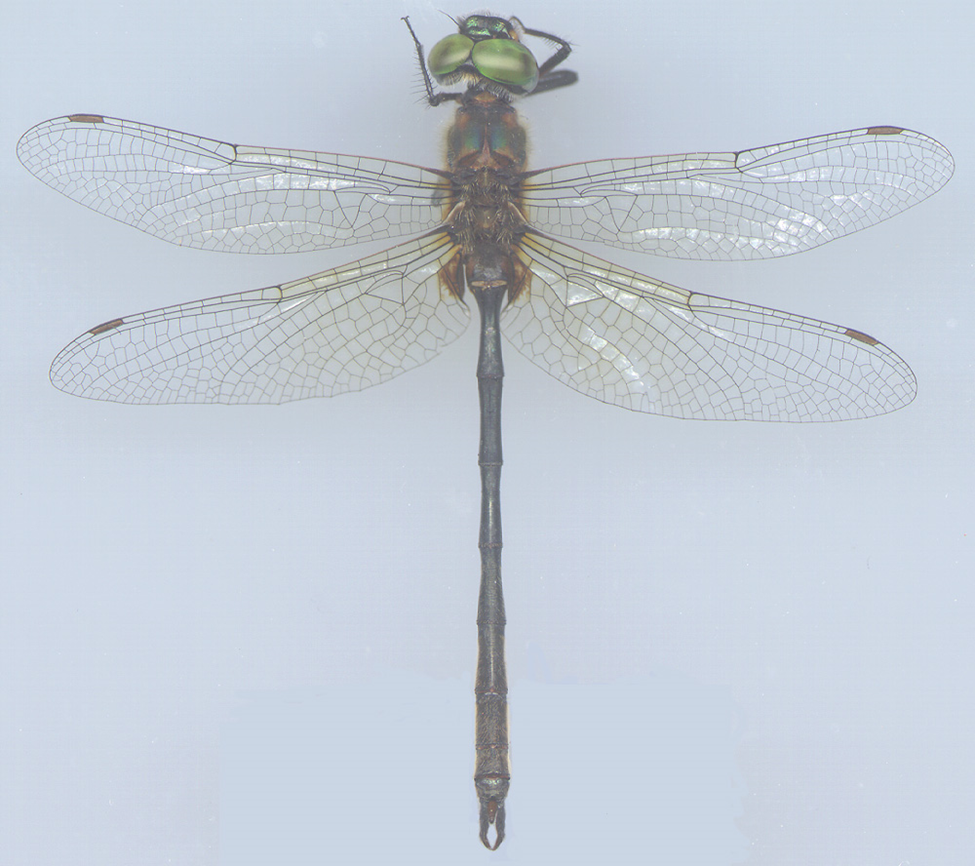
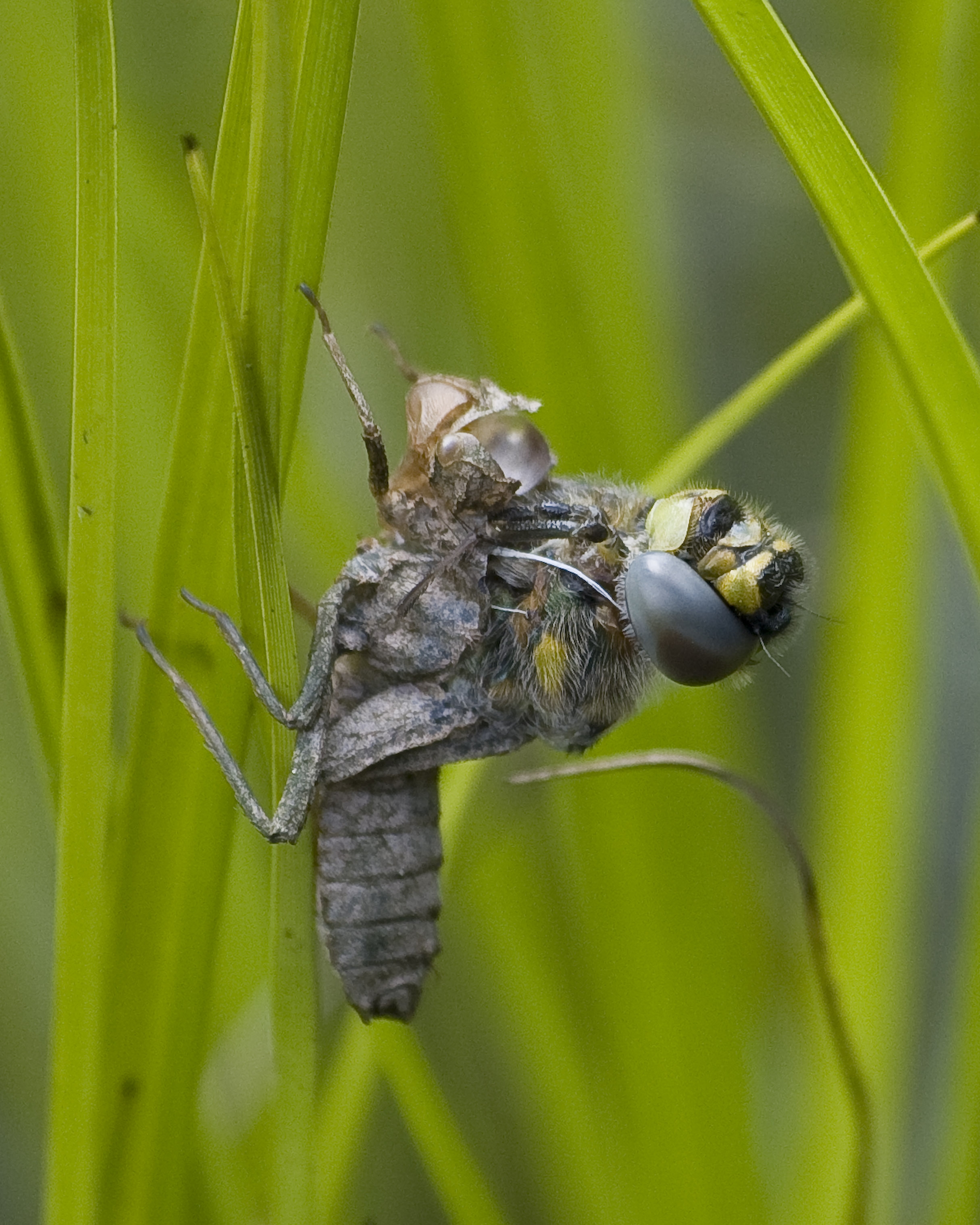
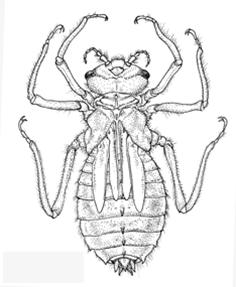
Adult flight period in Washington is 30 Jul- 24 Aug (Paulson 2007). Males fly back and forth at waist height, with frequent hovering, patrolling the aquatic habitat for females (Bryan 2008, Paulson 2008, pers. comm.). Females oviposit by tapping the abdomen onto wet moss or water in tiny pools (Paulson 2008, pers. comm.). Adults perch by hanging, either vertically or obliquely, from vegetation. Like all odonates, the majority of the life cycle is spent as aquatic larvae. The larvae of this species are sprawlers, living on the surface of floating leaves or fine sediment (Merritt et al. 2008), where they “sit-and-wait” to ambush and engulf their prey (Packauskas 2005).
Global Range: Widely distributed across Canada and northeastern United States (Abbott 2007); most likely to be encountered in sphagnum bogs and very shallow well-vegetated waters in mountainous regions (Bryan 2008).
Washington: Known from one site in Pend Oreille Co.: a patterned sedge fen in Bunchgrass Meadows at 1524 m (5000 ft.) elevation (Paulson 2007).
Oregon: This species has not been found and is not expected in Oregon.
Federal land: Documented from Bunchgrass Meadows on the Colville National Forest (Sullivan Lake Ranger District). Bunchgrass Meadows is now an official Research Natural Area.
Abundance estimations are not known for this species.
This species is found in sedge- and moss-filled fens, at the foot of hillsides below seepage or in wide-open meadows. It is not usually encountered near open water. Adult males fly through stretches of tall grasses, sedges, and shrubs (Paulson 2008, pers. comm.).
Bunchgrass Meadows, the only known habitat for this species in Washington, is a high elevation patterned sedge fen. Other highly specific habitat types have been documented in this genus. For example, the endangered S. hineana (Hine’s Emerald), currently known only from the midwestern United States, favors small seeps draining calcareous escarpments through heavily vegetated wetlands (Bright 2005).
Global Status (2004): G5
Rounded Global Status: G5 – Secure
National Status (United States): N3N4
National Status (Canada): N5
State Statuses: Alaska (SNR), Maine (S5), Michigan (SNR), Minnesota (SNR), New Hampshire (SNR), New York (SNR), Vermont (S2), Washington (S1), Wisconsin (S2S3).
(NatureServe 2008).
Although this species is widely distributed across Canada and considered globally secure, it is unranked or considered imperiled in most states (secure in Maine). Bunchgrass Meadows, the one known site for this species in Washington, is a unique and interesting site for Odonata. It is also the only known Washington site for another Somatochlora species (S. whitehousei), and home to a population of Coenagrion interrogatum, a narrow-wing damselfly which is quite rare and local in the state (Paulson 2008, pers. comm.). This site contains no non-native vascular plant species and is noticeably unique in terms of both animal and plant diversity (Ahlenslager 2008). It requires serious conservation efforts, and has recently gained federal protection as an official Research Natural Area (RNA) (USDA Forest Service 2008, Ahlenslager 2008, pers. comm.). The main goal of an RNA is to provide opportunities for non-manipulative and non-destructive research in ecosystems that are free from human impact and influenced only by natural processes. Current management of the Bunchgrass RNA includes prohibiting grazing, logging and mining, discouraging recreational use (horseback riding and berry picking are permitted), and reducing travel throughout the site.
Like other members of its genus, habitat disturbance and alteration are the greatest immediate threats to this species (Packauskas 2007). Specific activities that alter fen-habitat in Washington include peat mining, wetland grazing, manipulation of water levels, recreation, recreational development, and management of aquatic vegetation (Fleckenstein 2006). Although the population at Bunchgrass Meadows is now largely shielded from these threats (USDA Forest Service 2008), other potential populations in the area may not be. Insect and disease control (still allowed in Bunchgrass Meadows) may also threaten this species. Livestock grazing is not permitted within the Bunchgrass Meadows, although the LeClerc grazing allotment is adjacent to the RNA, and could potentially impact the hydrology of the site.
Climate-related changes in habitat suitability may threaten southernmost populations and shift the species’ distribution northward. Projected changes in this region include increased frequency and severity of seasonal droughts and flooding, reduced snowpack to feed river flow, increased siltation, and increased air and water temperatures (Field et al. 2007), all of which could impact this species and its habitat unfavorably. Moreover, since many aspects of odonate survival (e.g. development, phenology, immune function, pigmentation, and behavior) are sensitive to changes in temperature, global climate change is predicted to have serious consequences on this taxon (Hassall and Thompson 2008).
It is not known if disease and predation are serious threats to this species, but small populations are generally at greater risk of extirpation as a result of normal population fluctuations due to predation, disease, natural disasters, and other stochastic events.
Inventory: Survey for new sites near the known site at Bunchgrass Meadows, and elsewhere in northeast Washington. The species may occur in upland bog/fen habitat along the northern Washington border, a region that has not yet been surveyed for odonates (Paulson 2008, pers. comm.), and is in critical need of inventory. The Washington record is one of the southernmost extensions of this species’ global distribution. Since global climate change is expected to threaten southern populations, continued surveys and abundance estimations at Bunchgrass Meadows and surrounding areas would be valuable in evaluating distribution shifts, population declines, and other climate-driven effects.
Management: Manage habitat-disturbing activities to minimize impacts to sedge meadow, fen, and bog-habitat. The following should be considered for management of bog/fen habitat (Sargent and Carter 1999):
–Protect mineral-rich ground-water sources from pollution.
–Avoid destruction of existing hydrology (e.g. diverting, damming, or altering water flow).
–Avoid disturbance of plant community (e.g. grazing or harvesting peat or sphagnum).
–Do not use fertilizers in or near wetland area, since such pollution can drastically change plant communities, often in favor of invasive species.
–Create a buffer zone at least 91 m (100 yards) around the wetland (This can be done by planting shrubs/grasses, or by keeping the area free of disturbance, including roads and trails).
As wetlands throughout Washington are being increasingly impacted by human activities, continued preservation of Bunchgrass Meadows and its ecologically valuable species is critical. However, insecticides and herbicides intended to protect the uniqueness of the native biota should not be used without serious consideration of their sublethal and lethal effects on other sensitive taxa in the community.
Abbott, J.C. 2007. “Somatochlora franklini” OdonataCentral: An online resource for the distribution and identification of Odonata. 2007. Texas Natural Science Center, The University of Texas at Austin 3 Oct. 2008 <http://www.odonatacentral.org/>.
Ahlenslager, K. 2008. Email exchange with Sarah Foltz regarding the establishment of Bunchgrass Meadows as a Research Natural Area.
Bright, E. 2005. “Notes on the Michigan species of Somatochlora.” Odonata Larvae of Michigan. 7 July 2005. University of Michigan- Museum of Zoology. 7 Oct. 2008 <http://insects.ummz.lsa.umich.edu/michodo/test/Somatoch.htm>.
Bryan, N. 2008. “Delicate Emerald, Somatochlora franklini” Talk About Wildlife. 24 Oct. 2008 <http://talkaboutwildlife.ca/profile/?s=747>.
Field, C.B., Mortsch, L.D., Brklacich, M., Forbes, D.L., Kovacs, P., Patz, J.A., Running, S.W. and M.J. Scott. 2007. Chapter 14: North America. In: Climate Change 2007: Impacts, Adaptation and Vulnerability. Contribution of Working Group II to the Fourth Assessment Report of the Intergovernmental Panel on Climate Change (Parry, M.L., Canziani, O.F., Palutikof, J.P., van der Linden, P.J. and Hanson, C.E., eds.). Cambridge University Press, Cambridge, UK. Available at: www.ipcc.ch/pdf/assessment-report/ar4/wg2/ar4-wg2-chapter14.pdf.
Fleckenstein, J. 2006. “Coenagrion interrogatum Species Fact Sheet.” Interagency Special Status /Sensitive Species Program (ISSSSP). Jan. 2006. OR-WA Forest Service / Bureau of Land Management. 15 Oct. 2008 <http://www.fs.fed.us/r6/sfpnw/issssp/species-index/fauna-invertebrates.shtml>.
Hassall, C. and D.J. Thompson. 2008. The effects of environmental warming on Odonata: a review. International Journal of Odonatology 11(2):131-153.
NatureServe. 2008. “Somatochlora franklini.” NatureServe Explorer: An online encyclopedia of life [web application]. Feb. 2008. Version 7.0. NatureServe, Arlington, Virginia. 6 Oct. 2008 <http://www.natureserve.org/explorer/>
Packauskas, R.J. “Hudsonian Emerald Dragonfly (Somatochlora hudsonica): a technical conservation assessment.” 24 Aug. 2007. USDA Forest Service, Rocky Mountain Region. 16 Oct. 2008 <http://www.fs.fed.us/r2/projects/scp/assessments/hudsonianemeralddragonfly.pdf >
Paulson, D. 2008. E-mail exchange with Sarah Foltz, including content from his upcoming book, Dragonflies and Damselflies of the West, to be published by Princeton University Press, Spring 2009.
Paulson, D. 2007. “Washington Odonata.” Slater Museum of Natural History. Oct. 2007. University of Pugut Sound. 6 Oct. 2008 <http://www.ups.edu/x7041.xml>.
Sargent, M.S and Carter, K.S., ed. 1999. Managing Michigan Wildlife: A Landowners Guide. Michigan United Conservation Clubs, East Lansing, MI. 297pp.
Tennessen, K. 2007. Odonata Larvae of the Pacific Northwest: An Identification Manual. Created for use in a taxonomic workshop sponsored by the Xerces Society and held at Evergreen State College, Olympia, Washington, March 16-18, 2007.
USDA Forest Service 2008. Environmental Assessment. Bunchgrass Meadows Research Natural Area Establishment and Forest Plan Amendment. 27 Oct. 2008 .
Profile prepared by Sarah Foltz Jordan, The Xerces Society for Invertebrate Conservation

